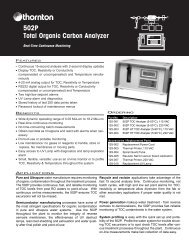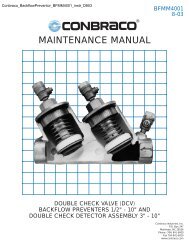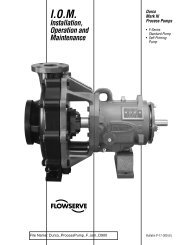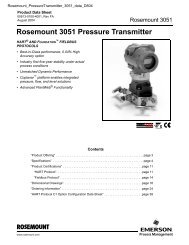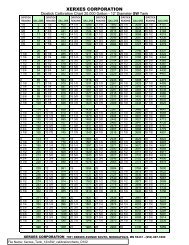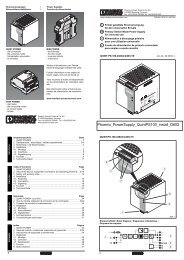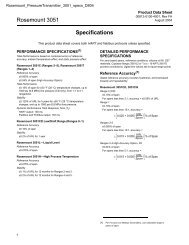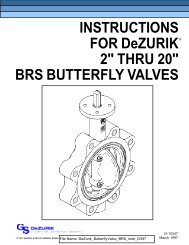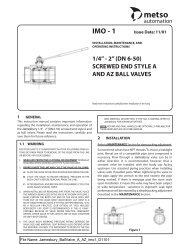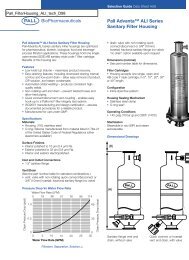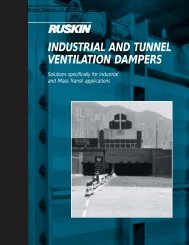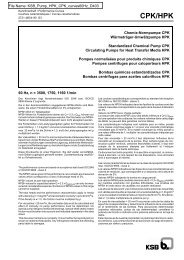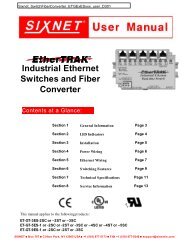USF RO ManualOMRX_6.pdf
USF RO ManualOMRX_6.pdf
USF RO ManualOMRX_6.pdf
Create successful ePaper yourself
Turn your PDF publications into a flip-book with our unique Google optimized e-Paper software.
<strong>USF</strong>ilter<br />
10 Technology Drive<br />
Lowell, Massachusetts 01851<br />
Tel: (800) 875-7873 • Fax: (978) 441-6025<br />
Email:<br />
Lowell_TechSupport@<strong>USF</strong>ilter.com<br />
Operation and<br />
Maintenance<br />
Manual<br />
for<br />
RX<br />
Med-<strong>RO</strong> Series<br />
Reverse Osmosis Systems<br />
Catalog # _______________________<br />
Serial # ________________________<br />
68/OMRX – Med-<strong>RO</strong> RX Manual 04/04 Rev. 6
CAUTION<br />
This System is for use in medical device applications and may not be<br />
modified, reconfigured, or used in a medical application other than that for<br />
which it is labeled. Modification of this system is a violation of federal law<br />
and will void all warranties.<br />
INDICATIONS<br />
Use of the US Filter Reverse Osmosis System is indicated when water for use in the preparation of<br />
dialysate fails to consistently meet the minimum requirements specified in the ANSI/AAMI approved<br />
Water Treatment Equipment for Hemodialysis Applications, RD-62:2001 and Canadian Standards<br />
Associations Z364.2.2. The US Filter Reverse Osmosis System may be used with any<br />
proportioning dialysis machine having a compatible water demand.<br />
CONTRAINDICATIONS<br />
There are no contraindications to reverse osmosis water treatment.<br />
CAUTIONS AND WARNINGS<br />
Procedures using the Reverse Osmosis System must be performed under the direction of a<br />
physician.<br />
Prior to operating or servicing this device, this manual must be read and understood. If something<br />
is not clear, call for assistance before proceeding. Keep this and other associated manuals for<br />
future reference and for new operators or qualified service personnel.<br />
All electrical work should be performed by a qualified electrician in accordance with the latest<br />
edition of the National Electrical Code, as well as local codes and regulations.<br />
To avoid electrical shock hazard, do not remove covers or panels when power is supplied to the<br />
device. Do not operate the device when covers or panels are removed.<br />
All plumbing must meet local codes and be performed by qualified technicians. Feed water must be<br />
from a potable source. A backflow preventer may be required.<br />
WARNING<br />
WARNING<br />
A faulty pump motor or wiring can be a serious shock hazard if it or<br />
surrounding water is accessible to human contact. To avoid this danger,<br />
DO NOT remove any grounding wire from the system.<br />
The Med-<strong>RO</strong> series <strong>RO</strong> systems are Class II medical devices in the United<br />
States and Class III in Canada designed to supply water for dialysis
applications. A warning alarm indicates an operational situation that could<br />
compromise a patient’s safety. DO NOT allow the unit to supply water to a<br />
dialysis application if the unit is in an alarm condition.<br />
DISCLAIMER STATEMENT<br />
This operation and maintenance manual is intended to be used with the component manufacturer<br />
literature provided in the Appendix. These manuals should provide complete and accurate<br />
information to meet your operating and/or service requirements based on the information available<br />
at the time of publication. However, <strong>USF</strong>ilter assumes no responsibility for the technical content of<br />
the manufacturer literature.<br />
This manual should be read fully and understood before installation, operation or maintenance of<br />
the system is attempted. The information in this manual may not cover all operating details or<br />
variations or provide for all conditions in connection with installation, operation and maintenance.<br />
Should questions arise which are not answered specifically in this manual, contact the <strong>USF</strong>ilter<br />
Technical Support Department at the phone number provided on the cover of this manual.<br />
<strong>USF</strong>ilter reserves the right to make engineering refinements that may not be reflected in these<br />
manuals. The material in these manuals is for informational purposes and is subject to change<br />
without notice and should not be construed as a commitment by <strong>USF</strong>ilter. <strong>USF</strong>ilter assumes no<br />
responsibility for any errors that may appear in this document. This manual is believed to be<br />
complete and accurate at the time of publication. In no event shall <strong>USF</strong>ilter be liable for incidental<br />
or consequential damages in connection with or arising from the use of this manual.<br />
WARNING<br />
The Med-<strong>RO</strong> series <strong>RO</strong> systems are registered medical devices. No enduser<br />
modifications to the unit should be made.<br />
©Copyright 2004 <strong>USF</strong>ilter<br />
Printed in the United States of America. All rights reserved.<br />
THIS BOOK OR PARTS THEREOF MAY NOT BE REP<strong>RO</strong>DUCED IN ANY FORM<br />
WITHOUT THE WRITTEN PERMISSION OF THE PUBLISHERS.
P<strong>RO</strong>PRIETARY RIGHTS STATEMENT<br />
This manual discloses information in which <strong>USF</strong>ilter has proprietary rights. Neither receipt nor<br />
possession of this manual confers or transfers any right to the client, and by its retention hereof, the<br />
client acknowledges that it will not reproduce or cause to be reproduced, in whole or in part, any<br />
such information except by written permission from <strong>USF</strong>ilter. The client shall have the right to use<br />
and disclose to its employees the information contained herein for the purpose of operating and<br />
maintaining the <strong>USF</strong>ilter equipment, and for no other purpose.<br />
In the event the content of this manual is altered or section/items are omitted during a reproduction,<br />
in whole or in part, and instructions or definitions within the reproduction result in personal injury to<br />
those who follow the altered instructions, the burden of responsibility for personal injury falls solely<br />
on the party who affects the reproduction.<br />
MANUAL USER’S GUIDE<br />
This manual describes the procedures necessary to install, operate, and maintain your <strong>USF</strong>ilter<br />
Reverse Osmosis system. Please read this manual carefully before installing and operating your<br />
equipment. The equipment warranty may be voided if installation or operation instructions are not<br />
followed correctly.<br />
Warnings, Cautions, and Notes are used to attract attention to essential or critical information.<br />
Warnings and Cautions will appear before the text associated with them, and notes can appear<br />
either before or after associated text.<br />
WARNING<br />
CAUTION<br />
Warnings indicate condition, practices, or procedures which must be<br />
observed to avoid personal injury or fatalities.<br />
Cautions indicate a situation that may cause damage or destruction of<br />
equipment or may pose a long term health hazard.<br />
NOTE: Notes are used to add information, state exceptions, and point out areas that<br />
may be of greater interest or importance.<br />
EQUIPMENT SUPPORT<br />
<strong>USF</strong>ilter continually strives to provide safe, efficient, trouble-free equipment using the optimum<br />
technology for your application. If problems should develop, <strong>USF</strong>ilter’s worldwide network of<br />
technical support will be available to provide assistance. For service, sales, parts, or additional<br />
manual copies call your area representative or <strong>USF</strong>ilter, Technical Support Department at the<br />
number provided on the cover of this manual.
TABLE OF CONTENTS<br />
SECTION DESCRIPTION PAGE<br />
1.0 INT<strong>RO</strong>DUCTION<br />
1.1 System Function.................................................................................... 1-1<br />
1.2 Quality Assurance/Quality Control......................................................... 1-1<br />
1.3 Functions of the System Components................................................... 1-2<br />
2.0 SYSTEM INSTALLATION<br />
2.1 Precautions Before Installation.............................................................. 2-1<br />
2.2 Unpacking.............................................................................................. 2-1<br />
2.3 System Location .................................................................................... 2-1<br />
2.4 Power Requirements ............................................................................. 2-2<br />
2.5 Water Requirements.............................................................................. 2-2<br />
2.6 Product Line .......................................................................................... 2-2<br />
2.7 Reservoir (optional) ............................................................................... 2-2<br />
2.8 Accessory Sensors (Pretreat Interlock & Tank Level) ........................... 2-3<br />
2.9 Setting the Flush Cycle Time and Duration ........................................... 2-3<br />
2.10 Before Power Turn On........................................................................... 2-3<br />
2.11 Installation of Reverse Osmosis Membrane(s)...................................... 2-4<br />
3.0 OPERATING INSTRUCTIONS<br />
3.1 Controls and Indicators.......................................................................... 3-1<br />
3.2 Initial Startup of Reverse Osmosis System ........................................... 3-1<br />
3.3 Initial Flushing of the System................................................................. 3-2<br />
3.4 Normal Operations................................................................................. 3-2<br />
3.5 Shutdown (Less Than 4 Days) .............................................................. 3-4<br />
3.6 Long Term Shutdown Procedure........................................................... 3-4<br />
4.0 SYSTEM MAINTENANCE<br />
4.1 General.................................................................................................. 4-1<br />
4.2 Sanitizing the Reverse Osmosis System............................................... 4-1<br />
4.3 Cleaning the <strong>RO</strong> Membranes ................................................................ 4-5<br />
4.4 Maintenance Schedule ......................................................................... 4-9
TABLE OF CONTENTS<br />
SECTION DESCRIPTION PAGE<br />
5.0 T<strong>RO</strong>UBLESHOOTING<br />
5.1 System Inoperative................................................................................ 5-1<br />
5.2 Low System Pressure............................................................................ 5-1<br />
5.3 Low Percent Recovery........................................................................... 5-1<br />
5.4 High Percent Recovery.......................................................................... 5-2<br />
5.5 Low Salt Rejection................................................................................. 5-2<br />
5.6 System Keeps Shutting Off.................................................................... 5-2<br />
5.7 System Shutoff, Low Pressure .............................................................. 5-2<br />
5.8 System Shutoff, High Temperature ....................................................... 5-3<br />
5.9 Low Product Flow Rate.......................................................................... 5-3<br />
5.10 Motor Overload Shutdown ..................................................................... 5-3<br />
5.11 Controller Malfunction............................................................................ 5-4<br />
6.0 WARRANTY<br />
6.1 General Limited Warranty...................................................................... 6-1<br />
6.2 Water System Limited Warranty ............................................................ 6-1<br />
7.0 APPENDIX<br />
7.1 Glossary of Terms ................................................................................. 7-1<br />
7.2 Replacement/Spare Parts List -- RX Model........................................... 7-2<br />
7.3 <strong>RO</strong> Data Collection Form....................................................................... 7-4<br />
7.4 QA Data Report ..................................................................................... 7-7<br />
7.5 Drawings................................................................................................ 7-8<br />
7.6 Component Manufacturers Literature.................................................... 7-9<br />
TABLE # DESCRIPTION PAGE<br />
4-1 Sanitization Times and Concentrations for Polyamide .......................... 4-2<br />
Thin Film Composite Membranes<br />
4-2 Cleaning Solutions for Polyamide.......................................................... 4-8<br />
Thin Film Composite Membranes
For Product and Service Information<br />
<strong>USF</strong>ilter<br />
10 Technology Drive<br />
Lowell, MA 01851<br />
Telephone: (978) 934-9349<br />
FAX: (978) 441-6025<br />
For Technical Support<br />
Telephone: (800) 875-7873 Extension 5000<br />
Email: Lowell_TechSupport@<strong>USF</strong>ilter.com
RX Manual 04/04 Rev. 6 INT<strong>RO</strong>DUCTION<br />
1.0 INT<strong>RO</strong>DUCTION<br />
Congratulations on your selection of this <strong>USF</strong>ilter water purification system. This system is<br />
designed and manufactured to the highest standard of quality and fully tested and inspected<br />
prior to shipment. In order to get maximum performance, we ask you to read all of the following<br />
instructions before installing and operating this system. Any warranty offered will be void unless<br />
directions are followed exactly.<br />
This manual is divided into sections for easy reference. Review this manual thoroughly and<br />
then return to section 2.0 System Installation for step-by-step installation instructions.<br />
If you need technical assistance in operating or maintaining your <strong>USF</strong>ilter unit, call your local<br />
representative. If you require further assistance call <strong>USF</strong>ilter, Technical Support Department at<br />
the phone number provided on the cover of this manual.<br />
1.1 SYSTEM FUNCTION<br />
The function of a Reverse Osmosis (<strong>RO</strong>) system is to remove contaminants from a<br />
water supply using a Reverse Osmosis (<strong>RO</strong>) membrane. The system produces purified<br />
water that is low in inorganic salts, organic matter and bacteria. The purified water can<br />
be used as a direct feed to a distribution system or stored in a reservoir.<br />
<strong>RO</strong> systems operate on the principle of passing water through the membrane under<br />
high-pressure. Some of the water passes through the membrane and is purified<br />
(product or permeate), the remainder of the water containing the impurities (concentrate<br />
or reject) is not passed through the membrane and is diverted to drain. In addition,<br />
portions of the product and reject are returned (product and reject recirc or recirculation)<br />
upstream of the pump to improve the operation and productivity of the <strong>RO</strong> system. A<br />
single prefilter is used in all systems to reduce the amount of particulate contamination<br />
reaching the membranes.<br />
Please refer to the Product Description/Equipment Specifications in the Appendix for<br />
other parameters important to the operation of the system.<br />
1.2 QUALITY ASSURANCE/QUALITY CONT<strong>RO</strong>L<br />
At <strong>USF</strong>ilter we have defined Quality Assurance and Quality Control into a series of<br />
engineering and manufacturing practices and control procedures to insure that you, our<br />
customer, receive the finest product available in the world. We will continue to update<br />
these practices and procedures on an ongoing basis in an effort to improve our systems<br />
and to insure that they continue to reflect state-of-the-art technology and reliability.<br />
Quality assurance is the cornerstone of our quality program. It begins with the selection<br />
and qualification of components and materials. Before suppliers are selected, their<br />
products must meet or exceed rigid standards set by our Quality Assurance Department.<br />
From that point, our incoming material inspection insures only reliable components will<br />
be used to manufacture systems. Numerous checks are performed as the system<br />
passes through the manufacturing process. The completed system must pass a series<br />
of tests before release for shipment to insure the system meets technical and<br />
performance specifications. In the Appendix is a copy of our Quality Assurance Data<br />
Report for your system.<br />
Quality audits do not improve products. They do, however, insure that each system<br />
meets or exceeds specifications required for your application.<br />
<strong>USF</strong>ilter 1-1
RX Manual 04/04 Rev. 6 INT<strong>RO</strong>DUCTION<br />
Customer feedback is also an important element of our program. Division heads meet<br />
on a routine basis to review customer feedback and initiate actions that result in process<br />
and product improvements.<br />
1.3 FUNCTIONS OF THE SYSTEM COMPONENTS<br />
Refer to the Process & Instrumentation Diagram (P&ID) in the Appendix.<br />
A. Low Feed Pressure Switch<br />
A low feed pressure switch protects the high-pressure pump. If the feed<br />
pressure to the pump falls below 15 psig the low feed pressure switch shuts the<br />
system down. The system will automatically restart four more times and if the<br />
low pressure situation has not been corrected after the fifth restart the system will<br />
remain shut down and will not restart until the alarm condition has been<br />
acknowledged and rectified.<br />
B. Reverse Osmosis Pump<br />
The <strong>RO</strong> system pump is a multiple stage centrifugal pump that is close coupled<br />
to an AC motor. The motor is a TEFC design and powered on and off through<br />
the controller by a motor starter.<br />
C. High Membrane Feed Pressure Switch<br />
A high membrane feed pressure switch protects the membranes and <strong>RO</strong><br />
pressure vessels from potentially damaging pressures. If the membrane<br />
pressure exceeds the safe operating pressure for the pressure vessels and/or<br />
membranes, the high-pressure switch shuts the system down and requires<br />
operator intervention prior to restart.<br />
D. Reverse Osmosis Membranes<br />
The prefiltered water enters the <strong>RO</strong> pressure vessel and passes over the surface<br />
of an <strong>RO</strong> membrane. A portion of the feed water continues out of the system<br />
through the reject and reject-recycle needle valves; and is either directed to drain<br />
or just upstream of the pump to increase the feed flow rate. The remainder of the<br />
water permeates the membrane (product) and is directed to an accessory<br />
storage reservoir or point of use. Percent recovery (the ratio of <strong>RO</strong> product water<br />
to feedwater) will vary depending on water quality and the application.<br />
E. Reject / Reject Recirculation Throttle Valves<br />
The flow rates of water exiting the <strong>RO</strong> membranes are controlled by the reject<br />
and reject recirculation valves. Closing the reject valve increases the pressure to<br />
the membranes and reduces the amount of water to drain. Recycling a portion of<br />
the reject water permits part of the total reject flow to be returned upstream of the<br />
pump and can improve <strong>RO</strong> performance and production. Reject recirculation can<br />
be used to increase the overall recovery of the system up to the scaling limit.<br />
F. Product Recirculation Valve<br />
Product recirculation permits excess product water to be returned upstream of<br />
the pump. This function is used when capacity exceeds demand, thus<br />
conserving water and increasing percent rejection (water quality).<br />
<strong>USF</strong>ilter 1-2
RX Manual 04/04 Rev. 6 INT<strong>RO</strong>DUCTION<br />
G. Autoflush Valve<br />
In the TANK FEED and STANDBY modes, the controller automatically opens the<br />
autoflush solenoid valve (located in the reject piping) for a predetermined<br />
duration at a preset interval, bypassing the reject needle valve, thereby flushing<br />
the concentrate line in a high flow, low pressure condition. The duration and<br />
interval of this flush cycle is operator settable and is determined by the fouling<br />
characteristics of the feedwater. In the DIRECT FEED mode the autoflush<br />
function is inhibited.<br />
H. Controller<br />
The controller has the following capabilities (please refer to the component<br />
manufacturer literature located in the Appendix for a more detailed explanation of<br />
these features):<br />
1. Low-pressure shutdown - The pump motor is shut down when the feed<br />
water pressure falls below 15 psig.<br />
2. High-pressure shutdown – The pump motor is shutdown when the<br />
pressure to the membranes exceeds the set point to prevent damage to<br />
the <strong>RO</strong> pressure vessels, membranes or other components.<br />
3. High temperature shutdown - The pump motor is shut down on high feed<br />
water temperature to protect the <strong>RO</strong> membranes from exposure to<br />
damaging temperatures.<br />
4. Low percent rejection alarm - The alarm function is activated when the<br />
percent rejection falls below determined limits to warn the operator the<br />
product water quality no longer meets specifications.<br />
5. Pump startup delay - There is a fifteen-second delay after pressing the<br />
system start button before the pump starts.<br />
6. Autoflush - The system automatically flushes the reject piping for a user<br />
settable duration at a user settable interval when the system is in either<br />
the STANDBY or TANK FEED mode.<br />
7. Tank full shutdown - The system shuts down when the level switch<br />
(optional) indicates that the storage tank (optional) is full. Automatic<br />
restart occurs after either a predetermined interval or when the low-level<br />
tank switch is activated and the user settable delay has expired.<br />
8. Pretreatment Interlock - This feature stops the system when the<br />
pretreatment equipment is in the regeneration cycle and restarts the<br />
system automatically when the regeneration cycle is completed.<br />
I. Accessories<br />
The <strong>RO</strong> system can be used to feed a distribution loop, another piece of<br />
equipment directly, or an accessory reservoir. If an accessory reservoir is used,<br />
a level switch or level switches are necessary and the controller must be<br />
operated in the TANK FEED mode. These accessories are connected to the<br />
controller enclosure by wiring the electrical leads to the high tank level and mid<br />
tank level switch input connections. Optional terminals (pretreatment interlock)<br />
have been placed in the controller enclosure for shutdown by external signals.<br />
Normal operation will resume automatically when the pretreatment regeneration<br />
is completed.<br />
<strong>USF</strong>ilter 1-3
RX Manual 04/04 Rev. 6 INT<strong>RO</strong>DUCTION<br />
See the installation section for instructions on electrical connection of the<br />
accessories.<br />
<strong>USF</strong>ilter 1-4
RX Manual 04/04 Rev. 6 SYSTEM INSTALLATION<br />
2.0 SYSTEM INSTALLATION<br />
2.1 PRECAUTIONS BEFORE INSTALLATION<br />
The following are feed water source requirements:<br />
A. Inlet pressure of 35 to 80 psig at design feed flow.<br />
B. Designed operating temperature is from 25 °C (77 °F) to 45 °C (113 °F). Contact<br />
technical support at the number on the manual’s front cover if operation below<br />
this is considered.<br />
C. Free chlorine concentration must be non-detectable on a continuous basis (
RX Manual 04/04 Rev. 6 SYSTEM INSTALLATION<br />
CAUTION<br />
The <strong>RO</strong> unit must be secured to the floor to prevent walking or tipping.<br />
Four ½” diameter holes are located on the frame base for bolting the unit<br />
to the floor.<br />
2.4 POWER REQUIREMENTS<br />
The power requirements for the system are given on the nameplate / serial number label<br />
located on the front of the system. The system should be connected with a<br />
multiconductor, grounded cable to a disconnect switch box. The switch box should be<br />
located within approximately 10 feet of the system for the convenience of technicians<br />
servicing the unit.<br />
Ground the power cable to the ground connection in the motor starter housing box.<br />
Branch circuit conductors supplying the motor shall have an amperage capacity of not<br />
less than 125% of the motor full load current rating as defined by the National Electric<br />
Code.<br />
2.5 WATER REQUIREMENTS<br />
The inlet water supply must be adequate to provide the minimum flow requirement<br />
shown in the Product Description/Equipment Specifications in the Appendix. The inlet<br />
line should be sized to deliver this flow with a recommended pressure of 35 psig at the<br />
<strong>RO</strong> unit. A shutoff valve within 10 feet of the unit should be provided. A sample valve for<br />
checking feed water quality is located upstream of the prefilter, thus ensuring a true feed<br />
water sample.<br />
2.6 P<strong>RO</strong>DUCT LINE<br />
At a minimum the field installed product line should be the same size as skid mounted<br />
product discharge from the <strong>RO</strong> system. In some cases it may be necessary to increase<br />
to the next pipe size to ensure against excessive pressure loss in the product to storage<br />
tank or point of use piping. A sample valve is located in the product line to facilitate<br />
sampling the quality of the product water. A flowmeter is supplied with the unit to<br />
continuously measure the product flow. The flowmeters supplied are fluid calibrated to<br />
obtain accurate flow measurements. Any replacement flowmeter should also be fluid<br />
calibrated.<br />
2.7 RESERVOIR (OPTIONAL)<br />
<strong>RO</strong> systems are designed to produce a constant supply of purified water. The<br />
membranes must be maintained in an operational or standby state to retain full<br />
effectiveness. Therefore, a reservoir is usually required, unless the system operates in<br />
direct-feed mode. The reservoir size is a function of space allocation in relation to<br />
system output. Therefore, size selection should be in accordance with this factor.<br />
<strong>USF</strong>ilter can supply reservoirs of any desired capacity as an accessory to the basic <strong>RO</strong><br />
system.<br />
<strong>USF</strong>ilter 2-2
RX Manual 04/04 Rev. 6 SYSTEM INSTALLATION<br />
2.8 ACCESSORY SENSORS (PRETREATMENT INTERLOCK AND TANK LEVEL(S)<br />
Provisions have been made for shutdown by accessory sensors, provided such sensors<br />
are equivalent to a single-pole, single-throw switch. When a shutdown condition exists,<br />
the <strong>RO</strong> system will resume normal operation automatically when the alarm condition has<br />
been corrected or no longer exists. Please refer to the steps that follow for installation<br />
instructions and locations (please refer to the <strong>RO</strong> Controller manual in the Appendix for<br />
further instruction).<br />
A. Open the controller enclosure door to expose the terminal connections.<br />
B. Dry contacts for the PRETREATMENT INTERLOCK should be connected<br />
between terminals 19 and 20 of the terminal strip. The HIGH TANK level switch<br />
input is connected between terminals 17 and 18. The MID TANK level switch<br />
input sensor is connected between terminals 15 and 16.<br />
NOTE: A normally closed switch or switches should be selected. The MC10 Controller<br />
may be used to connect one level switch to the controller (instructions are<br />
included with the MC10 manual located in the Appendix).<br />
C. To connect the accessory, remove the shorting wire where applicable and<br />
connect a single pole single throw normally closed sensor (TANK SWITCHES<br />
and PRETREATMENT INTERLOCK) between the respective terminals. It is<br />
recommended that shielded cable, properly grounded, be used to wire these<br />
sensors to avoid radio signal interference with these functions.<br />
2.9 SETTING THE FLUSH CYCLE TIME AND DURATION<br />
Refer to the MC10 <strong>RO</strong> Controller manual in the Appendix for detailed instructions.<br />
2.10 BEFORE POWER TURN ON<br />
CAUTION<br />
CAUTION<br />
CAUTION<br />
If an isolation valve is located downstream of the <strong>RO</strong> unit in the product,<br />
reject or autoflush piping, a pressure relief device must be installed to<br />
avoid an over pressurization condition that could irreversibly damage the<br />
<strong>RO</strong> unit and related components.<br />
Verify that all retaining “U” pins are in place on the <strong>RO</strong> pressure vessels<br />
before turning on the pump.<br />
Be sure the product water will not enter the user system during startup.<br />
The <strong>RO</strong> system must be operated for 24 hours to flush out the<br />
preservative solution before connecting to the user system.<br />
Once the feed water is plumbed to the system and the electrical power is connected, the<br />
electrician should verify correct motor rotation.<br />
<strong>USF</strong>ilter 2-3
RX Manual 04/04 Rev. 6 SYSTEM INSTALLATION<br />
2.11 INSTALLATION OF REVERSE OSMOSIS MEMBRANE(S)<br />
CAUTION<br />
CAUTION<br />
Never engage or disengage retaining “U” pins without wearing safety<br />
glasses.<br />
Never allow the <strong>RO</strong> membrane to dry out once it has been wet, or<br />
irreversible damage will result.<br />
<strong>USF</strong>ilter Reverse Osmosis units are normally shipped with the membranes installed and<br />
preserved in sodium bisulfite solution. However, should the need arise, the following<br />
procedures may be followed to install membranes:<br />
A. Disconnect all tubing from all <strong>RO</strong> pressure vessel end caps. This is done by<br />
pushing in the outer ring of the quick disconnect fitting while at the same time<br />
pulling the tubing out of the fitting.<br />
B. Remove <strong>RO</strong> pressure vessels from the frame, taking care to identify their proper<br />
location(s).<br />
C. Remove all “U” pins and end caps from each <strong>RO</strong> pressure vessel.<br />
D. Remove the each <strong>RO</strong> membrane from the <strong>RO</strong> pressure vessel in the same<br />
direction in which the feed water flows through it.<br />
E. Before installing the new <strong>RO</strong> membrane, lightly lubricate the brine (chevron) seal<br />
and o-rings with glycerin or water.<br />
F. Load the <strong>RO</strong> membrane in the direction in which the feed water will flow,<br />
inserting the end without a brine (chevron) seal first. Be careful not to roll, cut or<br />
otherwise damage the brine (chevron) seals when loading each membrane.<br />
G. Replace the end cap into the <strong>RO</strong> pressure vessel end opposite from loading end.<br />
Secure the end cap with the retaining “U” pin.<br />
H. Install the end cap on the feed end and secure it with the other “U” pin.<br />
I. Re-install <strong>RO</strong> pressure vessels onto the frame in their proper location(s).<br />
J. Reconnect the tubing to all end cap tube fittings by pushing into the fitting until<br />
the tubing “locks” into place.<br />
<strong>USF</strong>ilter 2-4
RX Manual 04/04 Rev. 6 OPERATING INSTRUCTIONS<br />
3.1 CONT<strong>RO</strong>LS AND INDICATORS<br />
3.0 OPERATING INSTRUCTIONS<br />
The controls and indicators used in the operation of the system are outlined in the MC10<br />
<strong>RO</strong> Controller manual located in the Appendix. The operator must be thoroughly familiar<br />
with the controls and their respective functions for proper operation and in order to<br />
maintain the quality of the product and eliminate unnecessary shutdowns.<br />
3.2 INITIAL STARTUP OF REVERSE OSMOSIS SYSTEM<br />
CAUTION<br />
CAUTION<br />
CAUTION<br />
Verify that all <strong>RO</strong> pressure vessel end cap retaining “U” pins are in place<br />
and secure.<br />
Do not run the motor for more than 30 seconds backwards or irreversible<br />
pump damage may result.<br />
The membrane feed pressure should not be allowed to exceed 250 psig at<br />
any time during operation.<br />
A. The operator should verify that appropriate pretreatment is in place and operating<br />
satisfactorily. Inappropriate or inoperative pretreatment can damage the<br />
membranes.<br />
B. Make all water, electrical, and drain connections according to installation<br />
instructions.<br />
C. Divert the outlet of the product water to a convenient drain.<br />
D. Turn on the feed water and the electrical power. With product water diverted to<br />
drain, fully open the reject throttling valve and close the reject recirculation<br />
throttling valve.<br />
E. Place the controller in the DIRECT FEED mode (refer to the Reverse Osmosis<br />
Controller manual in the Appendix for detailed instructions). Press the SYSTEM<br />
START button on the controller keypad to start the system, after a fifteen-second<br />
delay the pump should start.<br />
F. Check for proper pump rotation. (Please refer to the Pump Information, included<br />
in the Appendix of this manual for information concerning motor rotation and any<br />
other electrical requirements.)<br />
G. Set the reject recirculation flow to zero, but do not exceed 250 psig pressure to<br />
the membranes. Open the reject valve further if necessary to avoid over<br />
pressuring the system.<br />
CAUTION<br />
Do not use reject recirculation option for the first 4 hours of operation to<br />
speed flush up of the system.<br />
<strong>USF</strong>ilter 3-1
RX Manual 04/04 Rev. 6 OPERATING INSTRUCTIONS<br />
H. Set the percent rejection alarm setting to 90%.<br />
I. Check for plumbing leaks and make appropriate repairs as necessary. All<br />
systems are leak checked at the factory but vibration during transit can cause<br />
new leaks to develop.<br />
J. Once the system is checked out and operating correctly, place the controller in<br />
the desired mode. Read the next section on initial flushing before directing<br />
product water to the water storage tank or user system.<br />
3.3 INITIAL FLUSHING OF THE SYSTEM<br />
Since the <strong>RO</strong> membranes are shipped with sodium bisulfite preservative solution, initial<br />
flushing of the system is required. Before operating a new system, and also after the<br />
replacement of a <strong>RO</strong> membrane, perform the following steps:<br />
A. Direct the product water to a convenient drain.<br />
B. Ensure a steady feed water supply, turn on the system pump and let the system<br />
run for 24 hours. This will flush residual bisulfite solution and any particulate<br />
impurities from the membranes, housings and plumbing of the system.<br />
C. Product quality will increase slowly for 1 hour. Monitor the inlet quality vs. the<br />
product quality by observing the conductivity meter outputs.<br />
NOTE: The system should have better than 90% rejection within 2 hours as the<br />
membranes equilibrate. If the product quality does not improve, refer to<br />
section 5.0 Troubleshooting.<br />
D. After flushing product to drain for a minimum 24 hours, turn off the system and<br />
reconnect the product line. The system is now ready to be put into a normal<br />
operating mode. Refer to the Product Description/Equipment Specifications in<br />
the Appendix for design flowrates and pressures.<br />
3.4 NORMAL OPERATIONS<br />
The following procedure is for operating a <strong>USF</strong>ilter Reverse Osmosis System that has<br />
been installed and initial flushing has been completed. Refer to the MC10 Controller<br />
manual in the Appendix for detailed instructions.<br />
<strong>USF</strong>ilter 3-2
RX Manual 04/04 Rev. 6 OPERATING INSTRUCTIONS<br />
Use this section for daily startup or to restart the system after a short-term shutdown.<br />
A. BEFORE starting the <strong>RO</strong> unit, verify that the following conditions exist:<br />
DEVICE CONDITION<br />
Pump discharge throttling valve ¼ to ½ OPEN<br />
Reject throttling valve ¼ to ½ OPEN<br />
Reject recirc throttling valve 1/8 to ¼ OPEN<br />
Any valves in the reject to drain line OPEN<br />
Any valves in the process supply line OPEN<br />
Pre treatment equipment ready for use<br />
Storage tank (if applicable) ready for use<br />
IF ALL THE ABOVE CONDITIONS EXIST, THE SYSTEM IS READY TO START. IF ONE OF<br />
THE SETTINGS IS INCORRECT, CORRECT THE SETTING PRIOR TO P<strong>RO</strong>CEEDING.<br />
B. Verify the Controller is set to the proper operating mode, either TANK FEED or<br />
DIRECT FEED as described in the MC10 <strong>RO</strong> Controller manual in the Appendix.<br />
C. Press the SYSTEM START button on the Controller. This will start the system.<br />
The inlet solenoid valve will open then the pump will start after a 15 second<br />
delay.<br />
D. Verify that the product, reject, and product & reject recirculation flows are correct.<br />
If not, adjust the pump discharge throttling valve, reject valve, and product &<br />
reject recirculation valves. Refer to the Product Description/Equipment<br />
Specifications for design flowrates and pressures. Adjustment procedure:<br />
First, adjust the unit to make the correct amount of <strong>RO</strong> product water by<br />
adjusting the system pressure. This can be accomplished by regulating the<br />
pump discharge throttling valve. Further open the valve to increase the system<br />
operating pressure and productivity, further close the valve to reduce the system<br />
operating pressure and productivity.<br />
Second, adjust the unit to make the correct amount of reject to drain flow by<br />
adjusting the reject throttling valve. Open the valve to obtain a higher flow rate or<br />
close the valve to reduce the flow rate.<br />
Third, adjust the unit to make the correct amount of product and reject<br />
recirculation flows by adjusting the product and reject recirculation throttling<br />
valves. Further open the valve to obtain a higher flow rate or close the valve to<br />
reduce the flow rate.<br />
NOTE: Creating an equilibium may require several adjustments in that as you<br />
close the reject valves, the product flow increases and the reject flow<br />
decreases. As you open the pump discharge-throttling valve, the product<br />
and the reject flow increase. You may have to adjust the pump<br />
discharge-throttling valve to reestablish the operating pressure to obtain<br />
the correct product flow as established in the first step.<br />
<strong>USF</strong>ilter 3-3
RX Manual 04/04 Rev. 6 OPERATING INSTRUCTIONS<br />
E. Once the <strong>RO</strong> unit is operating at the parameters outlined in this manual, record<br />
the operating parameters on the “<strong>RO</strong> Data Collection Form” as described in<br />
Section 4.4, and found in the Appendix. It is imperative to record the operating<br />
parameters daily, since <strong>RO</strong> troubleshooting may require a trended analysis of the<br />
<strong>RO</strong> operating parameters.<br />
NOTE: If the <strong>RO</strong> will not start, or cannot achieve the correct flows, go to the<br />
troubleshooting section for more information.<br />
3.5 SHUTDOWN (LESS THAN 4 DAYS)<br />
CAUTION<br />
If the shutdown is due to a malfunction, be sure to disconnect the<br />
electrical power and turn off the water supply before making repairs or<br />
replacements.<br />
If the system is not to be operated for up to 4 days, the system should be placed in the<br />
STANDBY mode. When in this mode the <strong>RO</strong> system cycles on and off continuously for<br />
a duration and interval established by the user until the mode of operation is changed<br />
again. This mode will allow the system to return to normal (TANK or DIRECT FEED<br />
mode) operation at any time with no adverse affects on the water quality or <strong>RO</strong><br />
membranes.<br />
3.6 LONG TERM SHUTDOWN P<strong>RO</strong>CEDURE<br />
If the system is to be down for a period longer than 4 days, it is recommended that a<br />
biocide be pumped into the membrane elements to prevent biological growth.<br />
CAUTION<br />
Failure to store the membranes in a biocide for long term shutdown can<br />
cause irreversible damage to the membranes due to bacterial growth.<br />
NOTE: Contact your local <strong>USF</strong>ilter representative to aid in preparing your <strong>RO</strong> system<br />
for long term shutdown and storage.<br />
The solution <strong>USF</strong>ilter recommends is a 0.5 to 1.0% solution of sodium bisulfite. For<br />
conditions where freezing may be a problem, the solution should also contain up to 18%<br />
(by weight) glycerin or propylene glycol. Refer to <strong>RO</strong> membrane data sheet in Appendix<br />
for further information.<br />
The following equipment and materials are needed:<br />
CIP Cleaning Skid<br />
<strong>RO</strong> Product Water or DI Water<br />
Sodium Bisulfite (food grade)<br />
Propylene Glycol or Glycerin (if required)<br />
Safety Equipment<br />
<strong>USF</strong>ilter 3-4
RX Manual 04/04 Rev. 6 OPERATING INSTRUCTIONS<br />
CAUTION<br />
A. Fill the tank on the cleaning skid with the appropriate quantity of <strong>RO</strong> product<br />
water or DI water.<br />
Do not use a solution of greater than 1.0% bisulfite. The pressure vessel<br />
endcaps will be damaged otherwise.<br />
B. Add the correct amount of sodium bisulfite powder to the cleaning tank using the<br />
following proportions:<br />
0.5% solution sodium bisulfite - .042 lbs. per gallon<br />
1.0% solution sodium bisulfite - .084 lbs. per gallon<br />
If applicable, add the appropriate amount of freeze protection (glycerin or<br />
propylene glycol) to the solution at this point.<br />
C. Once the bisulfite solution is thoroughly mixed, allow the solution to circulate<br />
through the <strong>RO</strong> unit for 30 minutes.<br />
D. Fully close the manual feed water isolation valve and install a Lock-Out device<br />
and a Lock-Out Tag on the valve.<br />
E. If applicable, you may also have to fully close any process valves located in the<br />
<strong>RO</strong> unit product line down stream of the product line to prevent unwanted <strong>RO</strong><br />
product water from passing this point, and install a Lock-Out device and a Lock-<br />
Out Tag on the valve.<br />
F. Drain the pump and manifold piping.<br />
G. Seal all openings to prevent the membrane elements from drying out.<br />
H. Tag the <strong>RO</strong> unit with the date and type of solution the membranes are stored in<br />
so that it is properly flushed prior to being put back into service.<br />
The <strong>RO</strong> unit is now ready to be stored. Be sure to follow the Initial Startup in<br />
Section 3.2 when ready to put the unit back in service.<br />
<strong>USF</strong>ilter 3-5
RX Manual 04/04 Rev. 6 SYSTEM MAINTENANCE<br />
4.1 GENERAL<br />
4.0 SYSTEM MAINTENANCE<br />
Routine customer maintenance procedures consist of daily checks of the system to<br />
record operating data, periodic replacement of the prefilter cartridge and sanitization and<br />
cleaning of the <strong>RO</strong> membranes. The prefilter cartridge should be changed monthly or<br />
when the differential pressure reaches 10-15 psig, whichever comes first. The <strong>RO</strong><br />
membranes should be cleaned when the normalized product flow rate drops by more<br />
than 15% or the salt rejection drops by more than 3%.<br />
NOTE: Contact your local <strong>USF</strong>ilter representative for assistance when the <strong>RO</strong> system<br />
requires cleaning.<br />
In addition, the system's external surface should be kept clean by occasionally wiping<br />
down all surfaces with a dust-free cloth and visually checking for cracked glass on<br />
gauges, loose fittings, and broken or missing hardware.<br />
Whenever the prefilter cartridge or <strong>RO</strong> membranes are replaced, inspect the<br />
serviceability of the o-ring seals prior to assembly. Inspect o-rings for signs of<br />
deterioration or cracking, and replace as required. It helps to lubricate o-rings with<br />
glycerin before re-assembly.<br />
4.2 SANITIZING THE REVERSE OSMOSIS SYSTEM<br />
WARNING<br />
WARNING<br />
CAUTION<br />
Verify that the system is not in use and Tag Out all points of use during the<br />
sanitization process.<br />
Verify sanitant has been flushed from the system by testing to nondetectable<br />
levels at the <strong>RO</strong> outlet and all points of use before returning the<br />
system to normal operation.<br />
Chlorine is not compatible with thin film composite <strong>RO</strong> membranes, and<br />
must not be used to sanitize them.<br />
Periodically, the <strong>RO</strong> System may require sanitization in order to maintain the<br />
performance of the <strong>RO</strong> membranes, and to ensure a low bacterial count in the product<br />
water. How frequently the system is sanitized depends on the quality of the water<br />
needed for your particular application. Monitor bacterial levels in the feed and permeate<br />
as needed. When bacterial levels increase above an acceptable level for the<br />
application, sanitize the system. Sanitization may be required as often as once a week<br />
or as infrequently as every three months depending on local feed water and operating<br />
conditions. Sanitization is recommended once a month to maintain peak operating<br />
conditions.<br />
The choice of the sanitizing agent depends on its compatibility with the polyamide thin<br />
film composite <strong>RO</strong> membranes and system components, and the agent’s effectiveness<br />
as a sanitant. The most commonly used sanitants are hydrogen peroxide and peracetic<br />
acid. Formaldehyde can also be used as a sanitant however it is rarely used due to<br />
stringent OSHA exposure limits.<br />
<strong>USF</strong>ilter 4-1
RX Manual 04/04 Rev. 6 SYSTEM MAINTENANCE<br />
A. Different Sanitizing Agents<br />
1. Peracetic Acid (Preferred Method)<br />
Advantages of using peracetic acid are that it has no toxic vapors, is<br />
biodegradable, easily disposable, and has good biocidal activity.<br />
Peracetic acid decomposes into oxygen, water, and acetic acid. Several<br />
peracetic acid solutions are commercially available, including; Minncare<br />
and Renalin Dialyzer Reprocessing Concentrate, both products of<br />
Minntech Corporation, and P3-Oxonia Active, a product of Henkel<br />
Corporation. For ordering information call the number provided on the<br />
cover of this manual.<br />
2. Hydrogen Peroxide<br />
Advantages of using hydrogen peroxide are that it has low toxic vapors, is<br />
biodegradable, is easily disposable, has good biocidal activity, and breaks<br />
down into oxygen and water.<br />
B. Selecting a Sanitant<br />
Table 4-1 lists the type and concentration of sanitizing agent that should be used for polyamide<br />
thin film composite membranes, as well as the minimum contact time for sanitization.<br />
Table 4-1: Sanitization Times and Concentrations for Polyamide TFC Membranes.<br />
Sanitant Sanitant Concentration Sanitant Contact Time<br />
Peracetic Acid * up to 400 ppm (0.04%) 60-120 minutes<br />
Hydrogen Peroxide * up to 2,000 ppm (0.2%) 60-120 minutes<br />
* When using hydrogen peroxide or peracetic acid with thin film composite membranes, the<br />
temperature should not exceed 25° C (77° F). Also, the presence of iron or heavy metals<br />
can cause membrane degradation. Clean the membranes first if iron is present in the<br />
feed water.<br />
<strong>USF</strong>ilter 4-2
RX Manual 04/04 Rev. 6 SYSTEM MAINTENANCE<br />
C. Testing for Residual Sanitant<br />
After flushing the sanitant from the <strong>RO</strong> system, the product water should be<br />
checked for residual levels of sanitizing agent before the system is placed back<br />
on line. Use the following guidelines to determine if the system is clear of<br />
residual sanitizing agents.<br />
1. Peracetic Acid<br />
The product water should be analyzed with the Peracetic Acid Residual<br />
Test Strip or other peracetic acid test kit. For ordering information call the<br />
number provided on the cover of this manual.<br />
2. Hydrogen Peroxide<br />
The product water should be analyzed with a hydrogen peroxide test kit.<br />
D. Methods of Sanitization<br />
Sanitization is most effective when the <strong>RO</strong> system is operating at normal<br />
pressure and flows. This allows the maximum amount of sanitant to penetrate<br />
through the membrane, ensuring adequate sanitization of the product side of the<br />
system. In addition, sanitant should contact all wetted components of the <strong>RO</strong><br />
system including prefilter housing, valves, flowmeters, and sample ports to<br />
ensure maximum effectiveness.<br />
Recirculation Method<br />
This method requires an accessory tank and booster pump clean in place<br />
(CIP) system US Filter model number MED<strong>RO</strong>CIP or equivalent system.<br />
A sanitant solution is prepared in the tank and fed to the <strong>RO</strong> system via<br />
the booster pump. The product and reject streams are diverted to the<br />
tank and the sanitant is recirculated through the system for a period of<br />
time.<br />
The advantages of the recirculation method of sanitization are minimal<br />
usage of chemical, and ease in obtaining the proper sanitant<br />
concentration. In addition, the accessory tank and booster pump may<br />
also be used for system cleaning.<br />
The following steps provide a general guideline for the recirculation<br />
method of sanitization.<br />
a. The <strong>RO</strong> system is put into sanitization lockout mode. During<br />
sanitization lockout the <strong>RO</strong> system will not run.<br />
b. A batch of sanitant, typically 15 to 50 gallons (60 to 200 liters) for<br />
the RX series <strong>RO</strong> systems is prepared in the CIP tank by diluting<br />
the sanitization chemical with pretreated <strong>RO</strong> feedwater or <strong>RO</strong><br />
product water, following the sanitant chemical manufacturer’s<br />
recommendation.<br />
c. Connect the cleaning CIP skid to the <strong>RO</strong> system. The product<br />
and reject lines are diverted back to the CIP tank. Use the <strong>RO</strong><br />
<strong>USF</strong>ilter 4-3
RX Manual 04/04 Rev. 6 SYSTEM MAINTENANCE<br />
pump discharge, reject, and product cleaning ports on the <strong>RO</strong><br />
system to make these connections.<br />
d. The cleaning skid pump is turned on and run for 30 to 60 minutes.<br />
Adjust the reject flow. Verify the reject, reject recycle, and product<br />
flows and ensure sanitant reaches these areas of the system.<br />
CAUTION Monitor the solution temperature during recirculation. Do not<br />
allow the temperature to exceed 25° C (77° F).<br />
e. The cleaning pump can be shut down and the sanitant can soak<br />
for a maximum contact time of 2 hours, including recirculation<br />
time.<br />
f. Divert the product and reject lines to drain. Flush the sanitant<br />
from the system, filling the CIP with pretreated <strong>RO</strong> feedwater.<br />
Continue flushing for 15-30 minutes to remove the residual<br />
sanitant. When flushing the chemical from the system, close the<br />
reject recirculation valve. This will rinse chemical out more<br />
efficiently since it is not recycled back to the front end of the<br />
system.<br />
g. The <strong>RO</strong> is switched back to the normal feed source and run in the<br />
normal operating mode with the product diverted to drain until all<br />
residual sanitization chemicals are flushed from the system.<br />
h. The CIP tank and booster pump are drained and flushed with<br />
clean water.<br />
i. A new prefilter is installed in the system prefilter housing.<br />
NOTE: The introduction of sanitant by filling the prefilter housing has not been tested<br />
and proven to be an effective method of sanitizing the <strong>RO</strong> system.<br />
<strong>USF</strong>ilter 4-4
RX Manual 04/04 Rev. 6 SYSTEM MAINTENANCE<br />
4.3 CLEANING THE <strong>RO</strong> MEMBRANES<br />
WARNING<br />
WARNING<br />
Verify that the system is not in use and Tag Out all points of use during the<br />
cleaning process.<br />
Verify cleaning solutions have been flushed from the system by testing to<br />
non-detectable levels at the <strong>RO</strong> outlet and all points of use before returning<br />
the system to normal operation.<br />
A. General Information<br />
This section includes general guidelines for developing a cleaning procedure for<br />
your particular application. When <strong>RO</strong> systems have adequate pretreatment and<br />
are properly operated, they do not require frequent cleaning. In time, however,<br />
the <strong>RO</strong> membranes can become fouled to a point where system performance is<br />
adversely affected, resulting in diminished product output or salt rejection. When<br />
the normalized product flow rate drops by 15% and/or the salt passage rises<br />
noticeably, this may indicate fouling of the <strong>RO</strong> membranes and a need for<br />
cleaning. However, other factors such as temperature decreases, or<br />
malfunctioning pretreatment systems, pressure controls and pumps may also<br />
cause these conditions. It is important to rule out these factors before cleaning<br />
the system.<br />
Clean the membranes if the system performance (based on flow rate or salt<br />
rejection) decreases because of membrane fouling. A 15% increase in the feed<br />
to reject differential pressure also indicates that cleaning is needed.<br />
Membrane foulants include colloidal materials such as aluminum and silica<br />
compounds precipitated metal hydroxides of iron and manganese, biological<br />
films, and calcium or magnesium carbonate scale. The type of cleaning solution<br />
(See Table 4-2) depends on the type of foulant present (organic compounds,<br />
metal hydroxides, Ca/Mg carbonates, etc.). The need for frequent cleaning<br />
(once a month or more), may indicate that pretreatment is inadequate.<br />
B. Factors to Consider when Cleaning <strong>RO</strong> Membranes<br />
1. Cleaning skid required.<br />
An accessory cleaning skid consisting of a tank and recirculation pump is<br />
required to effectively clean the system. The tank and pump should be of<br />
materials compatible with the cleaning chemicals. Plastic tanks and sealless<br />
(magnetic drive) plastic pumps are recommended. A tank capacity<br />
of 15-30 gallons is sufficient for the Med-<strong>RO</strong> series <strong>RO</strong> systems.<br />
2. Use <strong>RO</strong> product water for cleaning and rinse solutions.<br />
Use <strong>RO</strong> product water to prepare cleaning solutions, and as flush water<br />
between each cleaning step. If <strong>RO</strong> product water is not available, use<br />
<strong>USF</strong>ilter 4-5
RX Manual 04/04 Rev. 6 SYSTEM MAINTENANCE<br />
softened filtered tap water. Completely flush the system between<br />
applications of different cleaning solutions.<br />
3. Increase flow rates and decrease pressure.<br />
During cleaning, reject flow rates should be as high as possible without<br />
exceeding the maximum design flow of the system. The flow rate should<br />
be 8 - 12 gpm per vessel for the Med-<strong>RO</strong> series <strong>RO</strong> systems during<br />
cleaning. Pressure should be kept at a minimum during cleaning.<br />
Transmembrane pressure keeps foulants within or on the membrane<br />
surface during cleaning. The <strong>RO</strong> pump should be off during cleaning.<br />
4. Optimum temperature during cleaning:<br />
The <strong>RO</strong> membrane cleaning solutions should be maintained at an<br />
elevated temperature if possible. Cold water reduces the effectiveness of<br />
the cleaning solution. Do not exceed the following temperatures during<br />
cleaning:<br />
C. Cleaning Instructions<br />
pH Range Maximum Cleaning Temperature<br />
2-10 50°C (122°F)<br />
1-11 35°C (95°F)<br />
1-12 30°C (86°F)<br />
1. Connect the <strong>RO</strong> system cleaning port (CP) connections to the accessory<br />
cleaning skid. Flexible hose and tubing work best to connect the<br />
cleaning equipment with the system. The materials of construction of the<br />
valves and hose must be compatible with the cleaning solutions. Verify<br />
that all piping connections are secure.<br />
2. Mix the desired cleaning solution in the tank and warm to appropriate<br />
cleaning temperature.<br />
3. Pump the mixed cleaning solution into the <strong>RO</strong> system at low pressure at<br />
the recommended flow rate of per vessel. The pressure should be low<br />
enough that essentially no permeate is produced.<br />
4. Recirculate the cleaning solution through the <strong>RO</strong> system for 10 – 15<br />
minutes.<br />
5. Turn off the cleaning pump and allow the <strong>RO</strong> membranes to soak in the<br />
cleaning solution. The soak period may range from 1 hour to overnight,<br />
depending on how severely fouled the membranes are. Turn on the<br />
cleaning pump periodically to circulate the cleaning solution. If the<br />
cleaning solution becomes highly discolored during recirculation, discard<br />
it and repeat the application.<br />
<strong>USF</strong>ilter 4-6
RX Manual 04/04 Rev. 6 SYSTEM MAINTENANCE<br />
6. Recirculate the cleaning solution at 8-12 gpm per vessel for 30-60<br />
minutes. This high flow rate flushes out foulants removed from the <strong>RO</strong><br />
membranes.<br />
CAUTION If the system temperature approaches the maximum recommended<br />
operation temperature during recirculation, shut down the system<br />
and allow it to cool off before continuing the recirculation.<br />
7. Disconnect the <strong>RO</strong> system from the cleaning skid. Divert the product and<br />
reject lines to drain.<br />
8. Flush the cleaning solution from the system, starting with a 10 to 15<br />
minute manual flush cycle. Then place the system in the normal<br />
operating mode, and for the first ten minutes, reduce the feed pressure to<br />
approximately half of the normal operating pressure by opening the reject<br />
and reject recycle throttle valves. This prevents residual foulants from<br />
being impacted into the membrane. After ten minutes, return the system<br />
to normal operating pressure, and continue flushing until the product<br />
water is clear of all residual cleaning agents. To test for residual cleaning<br />
agents when using an acid or base, the pH of the product water would be<br />
equal to, or nearly equal to, the pH of the feed water. For other<br />
chemicals, the conductivity of the product should be equal to, or less<br />
than, the conductivity of the product before cleaning.<br />
<strong>USF</strong>ilter 4-7
RX Manual 04/04 Rev. 6 SYSTEM MAINTENANCE<br />
Table 4-2: Cleaning Solutions for Polyamide Thin Film Composite Membranes.<br />
0.1% (W) 1<br />
NaOH and pH12, 30°C<br />
max.<br />
or 1.0% (W) Na4EDTA<br />
and pH12, 30°C max.<br />
0.1% (W) 1<br />
NaOH and pH12, 30°C<br />
max.<br />
or 0.025% (W) NaDSS<br />
and pH12, 30°C max.<br />
0.1% STP<br />
and 1.0% (W) 1 Na4EDTA<br />
or 1.0% TSP and<br />
pH12, 30°C max.<br />
Inorganic<br />
Salts 2<br />
Metal<br />
Oxides<br />
(Iron)<br />
0.2% (W) 1 HCl BEST<br />
0.5% (W) 1 H3PO4 OK GOOD<br />
2.0% (W) 1 Citric Acid OK<br />
1.0% (W) 1 Na2S2O4<br />
GOOD<br />
NOTES:<br />
1. (W) Denotes weight percent of active ingredient.<br />
Inorganic<br />
Colloids<br />
(Silt)<br />
Silica Biofilms Organics<br />
OK BEST OK<br />
GOOD GOOD GOOD<br />
GOOD GOOD<br />
2. Inorganic Salts: CaCO3=Calcium Carbonate; CaSO4=Calcium Sulfate; BaSO4=Barium<br />
Sulfate.<br />
3. Cleaning chemical symbols: NaOH=Sodium Hydroxide; Na4EDTA is the Tetrasodium Salt of<br />
Ethyl Diamine Tetraacetic acid; NaDSS is Sodium Salt of Dodecylsulfate; STP is Sodium<br />
Triphosphate (Na5P3O10); TSP is Trisodium Phosphate (Na3PO4·12H2O); HCl is Hydrochloric<br />
Acid; H3PO4 is Phosphoric Acid; C3H4(OH)(CO2H)3 is Citric Acid; Na2S2O4 is Sodium<br />
Hydrosulfite.<br />
<strong>USF</strong>ilter 4-8
RX Manual 04/04 Rev. 6 SYSTEM MAINTENANCE<br />
4.4 MAINTENANCE SCHEDULE<br />
NOTE: The maintenance schedule for monitoring outlined is a minimum for the<br />
protection of the <strong>RO</strong> system. A more frequent monitoring schedule may be<br />
necessary. Consult your local <strong>USF</strong>ilter representative or call <strong>USF</strong>ilter,<br />
Technical Support Department at the number provided on the cover of this<br />
manual for assistance.<br />
Refer to the <strong>RO</strong> Data Collection Form in the Appendix.<br />
A. Feed water<br />
1. Check pressure daily; record weekly. Adjust as necessary to maintain 35<br />
to 80 psi.<br />
2. Monitor feed and product conductivity and record weekly.<br />
3. If there is a possibility of the presence of chlorine in the feed water,<br />
measure free chlorine weekly. (It must be non-detectable or the<br />
membranes may be damaged).<br />
4. If there is a possibility of significant pH variations (i.e. the feed is pH<br />
controlled) monitor and record pH weekly by independent pH meter or<br />
litmus paper.<br />
5. Measure total hardness monthly.<br />
6. Measure total alkalinity monthly.<br />
B. Prefilter<br />
1. Measure differential pressure daily; record weekly.<br />
2. Change prefilter cartridge when the differential pressure is greater than<br />
10 psi or every month, whichever occurs sooner.<br />
C. Pump<br />
1. Check pressures daily; record weekly.<br />
2. If the pressures have fallen off, check product, reject and reject<br />
recirculation flow rates.<br />
D. Conductivity<br />
1. Observe feed and product conductivity daily; and record weekly.<br />
2. Record percent salt rejection weekly.<br />
Conductivity Feed - Conductivity Product<br />
100 X = % Rejection<br />
Conductivity Feed<br />
E. Flow Rates<br />
1. Check daily and record product and reject flow rate weekly.<br />
2. Calculate the percent recovery using the following formula:<br />
<strong>USF</strong>ilter 4-9
RX Manual 04/04 Rev. 6 SYSTEM MAINTENANCE<br />
Product Flow Rate<br />
100 X = % Recovery<br />
Product Flow Rate + Reject Flow Rate<br />
The percent recovery should not exceed the design value shown on the<br />
Equipment Specifications sheet in the Appendix. If minimizing water usage is<br />
critical, the percent recovery should be maintained near, but not above the<br />
maximum value. Operating with too high a percent recovery will lead to<br />
premature fouling of the membrane.<br />
F. Bacteria<br />
1. For critical applications, such as dialysis and pharmaceuticals, measure<br />
the number of bacteria in the product water weekly. Record the results as<br />
colony forming units per milliliter (CFU/ml). Sanitize as necessary.<br />
2. For non-critical applications, measure the number of bacteria in the<br />
product water monthly. Record the results as colony forming units per<br />
milliliter (CFU/ml). Sanitize as necessary.<br />
G. If the maintenance log shows steady deterioration in results (product flow,<br />
percent rejection, etc.) corrective action should be taken. (Described in Section<br />
5.0 Troubleshooting.)<br />
<strong>USF</strong>ilter 4-10
RX Manual 04/04 Rev. 6 T<strong>RO</strong>UBLESHOOTING<br />
5.1 SYSTEM INOPERATIVE<br />
5.0 T<strong>RO</strong>UBLESHOOTING<br />
A. Check to see if power to the unit is turned on.<br />
B. Verify the controller indicates that the system is on, if not press the system start<br />
button.<br />
C. Verify that the motor starter relay is engaging, if not reset the overload relay. If<br />
the overload relay fails to reset, replace the overload relay or contact your<br />
<strong>USF</strong>ilter representative for further assistance.<br />
D. Check the motor starter coil for proper operation and replace if necessary.<br />
E. With a voltmeter check that power is being supplied to the motor. If proper<br />
voltage is going to the motor but it does not run, replace the motor or contact<br />
your <strong>USF</strong>ilter representative for further assistance.<br />
5.2 LOW SYSTEM PRESSURE<br />
A. If the feed pressure before the prefilter is too low, check for obstruction in<br />
equipment and piping between feed source and <strong>RO</strong> unit.<br />
B. If the feed pressure after the prefilter is below normal, check for high differential<br />
pressure across the prefilter (plugging), replace the filter cartridge.<br />
C. If the membrane feed pressure is below normal, verify that the pump is running.<br />
D. Verify that the reject, reject recycle and product flows are normal. If not, adjust to<br />
design flow rates using the Equipment Specifications located in the Appendix and<br />
recheck membrane feed pressure.<br />
E. If the flows cannot be adjusted to the above flow rates, slowly close the reject<br />
and reject recirculation valves to observe the maximum pressure to the<br />
membrane. Do this only briefly and do not completely close the valve. If this<br />
pressure does not exceed 150 psig, repair or replace the pump/motor.<br />
5.3 LOW PERCENT RECOVERY<br />
A. Check product, reject, reject recycle flow rates and feed pressures to be sure<br />
they are normal; adjust flows as necessary.<br />
B. If feed to membrane pressure exceeds normal by 10% and product flow is lower<br />
than normal at a given temperature, the <strong>RO</strong> membranes are beginning to fail.<br />
They should be cleaned or replaced.<br />
NOTE: Contact your local <strong>USF</strong>ilter representative for assistance when the <strong>RO</strong> system<br />
requires cleaning.<br />
<strong>USF</strong>ilter 5-1
RX Manual 04/04 Rev. 6 T<strong>RO</strong>UBLESHOOTING<br />
5.4 HIGH PERCENT RECOVERY<br />
A. Verify that the reject, reject recycle and product flows are normal. If not, adjust to<br />
design flow rates using the Equipment Specifications located in the Appendix.<br />
B. Set the membrane pressure to 200 psig.<br />
C. If the product flow is high after adjusting the pressures and flows, the <strong>RO</strong><br />
membrane o-rings may be leaking. Check percent rejection.<br />
5.5 LOW SALT REJECTION<br />
A. Verify that the feed water temperature has not increased substantially from<br />
normal. High temperatures can affect percent rejection, as temperature<br />
increases, percent rejection decreases.<br />
B. Check product, reject, reject recycle flow rates and feed pressures per the<br />
Equipment Specifications in the Appendix, and adjust flows/pressures as<br />
necessary.<br />
C. Another possibility is high CO2 content in the inlet water. CO2 readily permeates<br />
the membrane. High CO2 content water will also have a pH of less than 6.0.<br />
D. <strong>RO</strong> membrane o-rings may not be seated correctly, check the percent rejection<br />
for each individual membrane housing. Remove membranes and verify o-rings<br />
are seated correctly on any that are below 90% rejection.<br />
E. If the above possibilities are eliminated, <strong>RO</strong> membranes are beginning to fail.<br />
They should be cleaned or replaced.<br />
NOTE: Contact your local <strong>USF</strong>ilter representative for assistance when the <strong>RO</strong> system<br />
requires cleaning.<br />
5.6 SYSTEM KEEPS SHUTTING OFF<br />
A. Observe the controller indicators to see if they indicate the cause for system<br />
shutdown, if the controller is shutting the unit down refer to the <strong>RO</strong> controller<br />
section of this manual for further discussion.<br />
B. The motor is equipped with automatic thermal overload protection. If the motor<br />
gets too hot it will shut down. After it has cooled it will restart. Excessive amp<br />
draw can cause the motor to get too hot.<br />
C. If an optional sensor is being used (Tank Level switch(es), Pretreatment<br />
Interlock), check to verify the sensor is not shutting off the system.<br />
5.7 SYSTEM SHUTOFF, LOW PRESSURE<br />
A. Verify that the feed water pressure is above 15 psig.<br />
B. Check the differential pressure across prefilter(s). It should be less than 10 psig,<br />
if not replace the prefilter cartridge filter and recheck feed pressure.<br />
<strong>USF</strong>ilter 5-2
RX Manual 04/04 Rev. 6 T<strong>RO</strong>UBLESHOOTING<br />
C. Check the pump suction pressure. It should be greater than 15 psig, if not check<br />
for obstruction in piping between the prefilter and pump suction.<br />
D. Verify the low pressure switch is operating properly.<br />
5.8 SYSTEM SHUTOFF, HIGH TEMPERATURE<br />
A. Check incoming water temperature.<br />
B. The high temperature shut down is user settable and should activate around the<br />
35°C ± 3°C (95°F ± 5°F).<br />
C. The temperature thermistor (sensor) is combined in the feed conductivity probe<br />
circuitry. The probe may be replaced if it is giving an erroneous temperature<br />
indication. (Refer to the <strong>RO</strong> Controller manual in the Appendix for correct<br />
values.)<br />
5.9 LOW P<strong>RO</strong>DUCT FLOW RATE<br />
A. Low feed water temperature can substantially reduce the performance of the <strong>RO</strong><br />
unit.<br />
B. Adjust the reject throttling valve to increase membrane feed pressure, this<br />
adjustment should increase the product flow rate. Do not exceed 250 psig.<br />
C. If adjusting the reject throttling valve does not improve product flow rate, the <strong>RO</strong><br />
membranes are fouled and should be cleaned with an appropriate medium.<br />
Depending on the type of fouling suspected, various regeneration/cleaning<br />
solutions may be used.<br />
NOTE: Contact your local <strong>USF</strong>ilter representative for assistance when the <strong>RO</strong> system<br />
requires cleaning.<br />
5.10 MOTOR OVERLOAD SHUTDOWN<br />
A. Motor overload shutdown is caused by excessive amp draw. An overload relay<br />
is wired directly to the motor starter and it will shut the system down if it runs<br />
above the full load amp rating of the motor. Reset the overload relay by pressing<br />
the “RESET” button on the starter enclosure. If the unit continues to trip the<br />
overload relay and shutdown contact your local <strong>USF</strong>ilter representative or<br />
<strong>USF</strong>ilter Technical Support Department at the number provided on the cover of<br />
this manual.<br />
B. If the overload is shutting the unit down due to damage or binding within the<br />
pump/motor, repair or replace the pump/motor or contact your local <strong>USF</strong>ilter<br />
representative or <strong>USF</strong>ilter Technical Support Department at the number provided<br />
on the cover of this manual.<br />
5.11 CONT<strong>RO</strong>LLER MALFUNCTION<br />
Refer to the <strong>RO</strong> Controller manual in the Appendix for troubleshooting controller related<br />
malfunctions.<br />
<strong>USF</strong>ilter 5-3
RX Manual 04/04 Rev. 6 T<strong>RO</strong>UBLESHOOTING<br />
<strong>USF</strong>ilter 5-4
RX Manual 04/04 Rev. 6 WARRANTY<br />
6.1 GENERAL LIMITED WARRANTY<br />
6.0 WARRANTY<br />
<strong>USF</strong>ilter warrants the products manufactured by it against defects in materials and<br />
workmanship when used in accordance with the applicable instructions for a period of one<br />
year from the date of shipment of the products. <strong>USF</strong>ilter MAKES NO OTHER WARRANTY,<br />
EXPRESSED OR IMPLIED. THERE IS NO WARRANTY OF MERCHANTABILITY OR<br />
FITNESS FOR A PARTICULAR PURPOSE. The warranty provided herein and the data,<br />
specifications and descriptions of <strong>USF</strong>ilter products appearing in <strong>USF</strong>ilter’s published<br />
catalogs and product literature may not be altered except by express written agreement<br />
signed by an officer of <strong>USF</strong>ilter. Representations, oral or written, which are inconsistent<br />
with this warranty or such publications are not authorized and if given, should not be relied<br />
upon.<br />
In the event of a breach of the foregoing warranty, <strong>USF</strong>ilter’s sole obligation shall be to<br />
repair or replace, at its option, any product or part thereof that proves defective in materials<br />
or workmanship within the warranty period, provided the customer notifies <strong>USF</strong>ilter promptly<br />
of any such defect. The exclusive remedy provided herein shall not be deemed to have<br />
failed of its essential purpose so long as <strong>USF</strong>ilter is willing and able to repair or replace any<br />
nonconforming <strong>USF</strong>ilter product or part. <strong>USF</strong>ilter shall not be liable for consequential<br />
damages resulting from economic loss or property damages sustained by a customer from<br />
the use of its products.<br />
6.2 WATER SYSTEM LIMITED WARRANTY<br />
<strong>USF</strong>ilter warrants the water systems manufactured by it, BUT EXCLUDING MEMBRANES<br />
AND CARTRIDGES, against defects in materials and workmanship when used in<br />
accordance with the applicable instructions and within the operating conditions specified for<br />
the systems for a period of one year from the earlier of: (i) the date of installation; or (ii) 120<br />
days following the date of shipment. <strong>USF</strong>ilter MAKES NO OTHER WARRANTY,<br />
EXPRESSED OR IMPLIED. THERE IS NO WARRANTY OF MERCHANTABILITY OR<br />
FITNESS FOR A PARTICULAR PURPOSE. The warranty provided herein and the data,<br />
specifications and descriptions of <strong>USF</strong>ilter systems appearing in <strong>USF</strong>ilter’s published<br />
catalogs and product literature may not be altered except by express written agreement<br />
signed by an officer of <strong>USF</strong>ilter. Representations, oral or written, which are inconsistent<br />
with this warranty or such publications are not authorized and if given, should not be relied<br />
upon.<br />
In the event of a breach of the foregoing warranty, <strong>USF</strong>ilter’s sole obligation shall be to<br />
repair or replace, at its option, any product or part thereof that proves defective in materials<br />
or workmanship within the warranty period, provided the customer notifies <strong>USF</strong>ilter promptly<br />
of any such defect. The exclusive remedy provided herein shall not be deemed to have<br />
failed of its essential purpose so long as <strong>USF</strong>ilter is willing and able to repair or replace any<br />
nonconforming <strong>USF</strong>ilter system or component part thereof. <strong>USF</strong>ilter shall not be liable for<br />
consequential damages resulting from economic loss or property damages sustained by<br />
any customer from the use of its process systems.<br />
<strong>USF</strong>ilter 6-1
RX Manual 04/04 Rev. 6 WARRANTY<br />
Products or components manufactured by companies other than <strong>USF</strong>ilter or its affiliates<br />
(“Non-<strong>USF</strong>ilter Products”) are covered by the Warranty, if any, extended by the Product<br />
manufacturer. <strong>USF</strong>ilter hereby assigns to the purchaser any such warranty: however, <strong>USF</strong><br />
EXPRESSLY DISCLAIMS ANY WARRANTY, WHETHER EXPRESSED OR IMPLIED<br />
THAT THE NON-<strong>USF</strong> P<strong>RO</strong>DUCTS ARE MERCHANTABLE OR FIT FOR A PARTICULAR<br />
PURPOSE.<br />
<strong>USF</strong>ilter 6-2
RX Manual 04/04 Rev. 6 APPENDIX<br />
7.1 GLOSSARY OF TERMS<br />
7.0 APPENDIX<br />
The terms commonly used in reverse osmosis are defined below:<br />
ANION - Negatively charged ion, such as CO3 -- , SO4 -- , HCO3 -- , Cl - , NO3 - , etc.<br />
CATION - Positively charged ion, such as Ca ++ , Mg ++ , Fe ++ , Na + , K + , etc.<br />
CONCENTRATE (REJECT) - Concentrated portion of the feed remaining outside the<br />
membrane which is discarded.<br />
CONDUCTIVITY - A measure of salt concentration due to the ability of dissolved solids (ions) to<br />
conduct electricity, usually expressed as micromhos/cm.<br />
FEED - The feedwater pumped into a permeator under high-pressure.<br />
OSMOSIS - Osmosis is the diffusion of a solvent (such as pure water) from a dilute saline<br />
solution into a more concentrated saline solution through a semipermeable membrane<br />
separating the two solutions.<br />
OSMOTIC HEAD - Osmotic head (pressure) is the change in head resulting from water<br />
transport through the semipermeable membrane separating two saline solutions of different<br />
concentrations.<br />
PASSAGE - Ratio of permeate to feed concentration of a particular dissolved material,<br />
expressed in percent.<br />
PERMEATE (P<strong>RO</strong>DUCT) - The purified portion of the feed passing through the membrane.<br />
RECOVERY - Percent of feedwater converted into permeate.<br />
REVERSE OSMOSIS (<strong>RO</strong>) - The process by which incoming fluid (feed) is forced under highpressure<br />
through a reverse osmosis membrane. A portion of the fluid with concentrated ionic<br />
materials (concentrate) remains upstream of the membrane and is discarded (unless it is of<br />
interest in a particular application). The highly purified portion (permeate) which passed through<br />
the membrane would then be collected for use (as in a water purification application).<br />
REVERSE OSMOSIS (<strong>RO</strong>) MEMBRANE - An <strong>RO</strong> membrane is a semipermeable membrane<br />
generally in sheet or hollow fiber form which rejects not only dissolved materials, but also<br />
organics, submicron size colloidal materials and bacteria which may contaminate a high purity<br />
water system. The process is not absolute and therefore most reverse osmosis membranes are<br />
defined by their rejection characteristics.<br />
SOLUTE - Material (salts) dissolved by solvent (water).<br />
TOTAL DISSOLVED SOLIDS - Total dissolved inorganic salts present in the permeator stream<br />
<strong>USF</strong>ilter 7-1
RX Manual 04/04 Rev. 6 APPENDIX<br />
7.2 REPLACEMENT/SPARE PARTS LIST – RX MODEL<br />
PART NUMBER DESCRIPTION<br />
D1004490 FOR UNITS W/ 1-6 VESSELS: CARTRIDGE DUAL GRADIENT FILTER 5<br />
MIC<strong>RO</strong>N 10” BIG BLUE<br />
D1000237 FOR UNITS W/ 1-6 VESSELS: CARTRIDGE FILTER HOUSING, 10” BIG<br />
BLUE<br />
D1004512 FOR UNITS W/ 8, 9, OR 12 VESSELS: CARTRIDGE DUAL GRADIENT<br />
FILTER 5 MIC<strong>RO</strong>N 20” BIG BLUE<br />
D1000245 FOR UNITS W/ 9, 9, OR 12 VESSELS: CARTRIDGE FILTER HOUSING, 20”<br />
BIG BLUE<br />
B10012424 CARTRIDGE FILTER BOWL<br />
B10012167 CARTRIDGE FILTER O-RING<br />
15/03995-02 PRESSURE GAUGE 0-100 PSI SS BTM MT<br />
15/03995-04 PRESSURE GAUGE 0-600 PSI SS PNL MT<br />
15/03995-03 PRESSURE GAUGE 0-300 PSI SS PNL MT<br />
15/03995-06 PRESSURE GAUGE 0-300 PSI SS BTM MT<br />
CDRC4X40L <strong>RO</strong> MEMBRANE<br />
22/03994-01 LOW PRESSURE SWITCH<br />
22/16006-01 HIGH PRESSURE SWITCH<br />
05/02561-16 SOLENOID VALVE ADAPTER, 1” UNION (INLET STREAM)<br />
05/03993-16 SOLENOID VALVE 1 FPT 24V (INLET STREAM)<br />
05/03992-08 SOLENOID VALVE SS 1/2 FPT 24V (REJECT AUTOFLUSH)<br />
05/14353-12 P<strong>RO</strong>DUCT RECIRC PRESS RELIEF VALVE<br />
06/31019-02 PRESSURE VESSEL, 1M 401A SS 300 PSI<br />
P92844 END PLUG (OSMOTIK PRT# 35401)<br />
P92845 U-PIN RETAINER (OSMOTIK PRT# 35402)<br />
P92846 O-RING, END PLUG SEAL (OSMOTIK PRT# 32029)<br />
P92847 O-RING, TUBE SEAL (OSMOTIK PRT# 32030)<br />
05/01473-12 CHECK VALVE, 3/4 FPT, PVC<br />
05/02910-08 GLOBE VALVE, 1/2 FPT, SS<br />
05/02910-16 GLOBE VALVE, 1 FPT, SS<br />
P91141 SAMPLE VALVE<br />
21/06129-02 FLOWMETER 1-17 GPM<br />
21/03995-03 FLOWMETER 1-10 GPM<br />
18/03951-01 CONDUCTIVITY SENSOR 3/4 MPT<br />
03/03672-08 0.5 AMP FUSE FOR 460/575V MODELS ONLY<br />
03/03672-10 0.8 AMP FUSE FOR 380V MODELS ONLY<br />
03/03672-11 1 AMP FUSE<br />
04/30741-05 PUMP, 3 HP 230/460 TEFC GRUNDFOS CRI3-19<br />
04/30741-06 PUMP, 3 HP 575V TEFC GRUNDFOS CRI3-19<br />
04/30741-07 PUMP, 3 HP 380V TEFC GRUNDFOS CRI3-29<br />
<strong>USF</strong>ilter 7-2
RX Manual 04/04 Rev. 6 APPENDIX<br />
04/31972-06 PUMP, 7.5 HP 230/460V TEFC GRUNDFOS CRI5-20<br />
04/31972-07 PUMP, 7.5 HP 230/460V TEFC GRUNDFOS CRI5-24<br />
04/31972-08 PUMP, 7.5 HP 575V TEFC GRUNDFOS CRI5-20<br />
04/31972-09 PUMP, 7.5 HP 575V TEFC GRUNDFOS CRI5-24<br />
04/31972-11 PUMP, 7.5 HP 380V 50HZ TEFC GRUNDFOS CRI5-32<br />
04/31972-12 PUMP, 7.5 HP 380V 50HZ TEFC GRUNDFOS CRI5-36<br />
03/30557-01 STARTER 9A 24V 50/60HZ NON-RVS OPN 1N<br />
03/30558-01 STARTER 12A 24V 50/60HZ NON-RVS OPN 1N<br />
03/30560-01 STARTER 23A 24V 50/60HZ NON-RVS OPN 1N<br />
03/30561-01 STARTER 30A 24V 50/60HZ NON-RVS OPN 1N<br />
03/30565-04 OVERLOAD RELAY, 3.7-12A SS (C09-C23)<br />
03/30565-05 OVERLOAD RELAY, 12-32A SS (C09-C23)<br />
03/30565-06 OVERLOAD RELAY, 12-37A SS (C30-C37)<br />
03/30551-03 TRANSFORMER FOR 575V MODELS<br />
03/30551-01 TRANSFORMER FOR 460V MODELS<br />
03/30551-12 TRANSFORMER FOR 380V MODELS<br />
10/64045-08 NYLON TUBING 1/2 OD<br />
10/30006-01 PP TUBING 5/8 OD<br />
12/03998-18 ¾” HOSE, SS W/SS FITTINGS, 18” LONG<br />
12/03998-25 ¾” HOSE, SS W/SS FITTINGS, 25” LONG<br />
12/03998-33 ¾” HOSE, SS W/SS FITTINGS, 33” LONG<br />
12/15037-36 1” HOSE, SS W/SS FITTINGS, 36” LONG<br />
26/10715-01 LEVELING PAD<br />
03/03929-01 MC10 CONT<strong>RO</strong>LLER<br />
<strong>USF</strong>ilter 7-3
RX Manual 04/04 Rev. 6 APPENDIX<br />
7.3 <strong>RO</strong> DATA COLLECTION FORM<br />
SYSTEM IDENTIFICATION: ______________________________________<br />
WEEK ENDING DATE: __________________________________________<br />
See calculated values on next page.<br />
<strong>RO</strong> UNIT OPERATING PARAMETERS*<br />
<strong>RO</strong> Cartridge Filter Outlet Pressure (PSI)<br />
<strong>RO</strong> Cartridge Filter Inlet Pressure (PSI)<br />
<strong>RO</strong> Cartridge Filter Pressure Drop (PSI)<br />
S M T W T F S<br />
1<br />
Product Flow Rate (GPM)<br />
Reject Flow Rate (GPM)<br />
Feed Flow Rate (GPM) 2<br />
Reject Recirculation Flow Rate (GPM)<br />
Product Recovery (%) 3<br />
Feed Water Temperature ( o F)<br />
Feed Water pH (0-14)<br />
Feed Water Chlorine Concentration (PPM)<br />
Feed Water Total Hardness (PPM as CaCO3)<br />
Feed Water SiO2 (PPM as SiO2)<br />
Feed Water Conductivity (µS/cm)<br />
<strong>RO</strong> Product Conductivity (µS/cm)<br />
<strong>RO</strong> Final Reject Conductivity (µS/cm)<br />
<strong>RO</strong> Percent Rejection (%) 4<br />
<strong>RO</strong> Pump Discharge Pressure (PSI)<br />
<strong>RO</strong> Membrane Feed Pressure (PSI)<br />
<strong>RO</strong> Product Pressure (PSI)<br />
<strong>RO</strong> Final Reject Operating Pressure (PSI)<br />
<strong>RO</strong> Normalized Productivity (GPM) 5<br />
* If Applicable<br />
COMMENTS:<br />
DATA TAKEN BY:<br />
<strong>USF</strong>ilter 7-4
RX Manual 04/04 Rev. 6 APPENDIX<br />
Calculated Values:<br />
1: <strong>RO</strong> FILTER PRESSURE D<strong>RO</strong>P is equal to filter inlet pressure MINUS filter outlet<br />
pressure.<br />
2: <strong>RO</strong> FEED FLOW rate is equal to <strong>RO</strong> product flow PLUS the <strong>RO</strong> reject flow.<br />
3: <strong>RO</strong> P<strong>RO</strong>DUCT RECOVERY is equal to the <strong>RO</strong> product flow rate DIVIDED by the <strong>RO</strong><br />
feed flow rate, MULTIPLIED by 100.<br />
EXAMPLE: Product flow = 3 GPM<br />
Feed flow = 4 GPM<br />
(3 ÷ 4) x 100 = 75% recovery<br />
4: <strong>RO</strong> PERCENT REJECTION* is equal to the <strong>RO</strong> feed conductivity MINUS the <strong>RO</strong><br />
product conductivity, DIVIDED by the feed conductivity, TIMES 100.<br />
EXAMPLE: Feed conductivity = 380 µS/cm<br />
Product conductivity = 5 µS/cm<br />
{(380-5) ÷ 380} x 100 = 98.6% rejection<br />
* The <strong>RO</strong> Quality monitor is set up at the factory to display this value.<br />
5: NORMALIZED P<strong>RO</strong>DUCTIVITY is a true indication of membrane performance. It is<br />
calculated as follows:<br />
NPF = MPF X TCF X (125÷MFP)<br />
Where:<br />
NPF = NORMALIZED P<strong>RO</strong>DUCT FLOW<br />
MPF = MEASURED P<strong>RO</strong>DUCT FLOW<br />
TCF = TEMPERATURE CORRECTION FACTOR (See table next page)<br />
MFP = MEASURED MEMBRANE FEED PRESSURE<br />
EXAMPLE: MPF = 3.5 GPM<br />
FEED WATER TEMP = 60 o F, THEN TCF = 1.44<br />
MFP = 150 PSIG<br />
NPF = 3.5 x 1.44 x (125÷150)<br />
NPF = 3.5 x 1.44 x 0.833<br />
NPF = 4.2 GPM<br />
<strong>USF</strong>ilter 7-5
RX Manual 04/04 Rev. 6 APPENDIX<br />
<strong>RO</strong> FEED WATER TEMPERATURE CORRECTION FACTOR<br />
TEMP o F TCF TEMP o F TCF<br />
34 3.64 70 1.12<br />
36 3.18 72 1.08<br />
38 2.93 74 1.05<br />
40 2.68 76 1.02<br />
42 2.47 78 0.97<br />
44 2.29 80 0.93<br />
46 2.14 82 0.90<br />
48 2.01 84 0.88<br />
50 1.88 86 0.86<br />
52 1.77 88 0.82<br />
54 1.68 90 0.79<br />
56 1.59 92 0.77<br />
58 1.51 94 0.75<br />
60 1.44 96 0.73<br />
62 1.36 98 0.70<br />
64 1.30 100 0.68<br />
66 1.24 102 0.65<br />
68 1.17 104 0.63<br />
<strong>USF</strong>ilter 7-6
RX Manual 04/04 Rev. 6 APPENDIX<br />
7.4 QA DATA REPORT<br />
See QA Data Report that follows this page.<br />
<strong>USF</strong>ilter 7-7
RX Manual 04/04 Rev. 6 APPENDIX<br />
7.5 DRAWINGS<br />
Only the drawings checked below that apply to your system will be included in this section.<br />
Dwg/Doc # Model Description<br />
RX501-RX All Models Product Description/Equipment Specifications – RX Model<br />
RX501-001 M<strong>RO</strong>RX01XX P&ID, 1 Vessel – RX Model<br />
RX501-002 M<strong>RO</strong>RX02XX P&ID, 2 Vessel – RX Model<br />
RX501-003 M<strong>RO</strong>RX03XX P&ID, 3 Vessel – RX Model<br />
RX501-004 M<strong>RO</strong>RX04XX P&ID, 4 Vessel – RX Model<br />
RX501-005 M<strong>RO</strong>RX05XX P&ID, 5 Vessel – RX Model<br />
RX501-006 M<strong>RO</strong>RX06XX P&ID, 6 Vessel – RX Model<br />
RX501-008 M<strong>RO</strong>RX08XX P&ID, 8 Vessel – RX Model<br />
RX501-009 M<strong>RO</strong>RX09XX P&ID, 9 Vessel – RX Model<br />
RX501-012 M<strong>RO</strong>RX12XX P&ID, 12 Vessel – RX Model<br />
RX501-210 M<strong>RO</strong>RX01XX General Arrangement Drawing, 1 Vessel – RX Model<br />
RX501-220 M<strong>RO</strong>RX02XX General Arrangement Drawing, 2 Vessel – RX Model<br />
RX501-230 M<strong>RO</strong>RX03XX General Arrangement Drawing, 3 Vessel – RX Model<br />
RX501-240 M<strong>RO</strong>RX04XX General Arrangement Drawing, 4 Vessel – RX Model<br />
RX501-250 M<strong>RO</strong>RX05XX General Arrangement Drawing, 5 Vessel – RX Model<br />
RX501-255 M<strong>RO</strong>RX05DX General Arrangement Drawing, 5 Vessel – RX Model (50 Hz)<br />
RX501-260 M<strong>RO</strong>RX06XX General Arrangement Drawing, 6 Vessel – RX Model<br />
RX501-265 M<strong>RO</strong>RX06DX General Arrangement Drawing, 6 Vessel – RX Model (50 Hz)<br />
RX501-280 M<strong>RO</strong>RX08XX General Arrangement Drawing, 8 Vessel – RX Model<br />
RX501-290 M<strong>RO</strong>RX09XX General Arrangement Drawing, 9 Vessel – RX Model<br />
RX501-300 M<strong>RO</strong>RX12XX General Arrangement Drawing, 12 Vessel – RX Model<br />
SV301-051 M<strong>RO</strong>RXXXAX Electrical Schematic, 208V/3Ph/60Hz, RX Model<br />
SV301-052 M<strong>RO</strong>RXXXBX Electrical Schematic, 230V/3Ph/60Hz, RX Model<br />
SV301-053 M<strong>RO</strong>RXXXCX Electrical Schematic, 460V/3Ph/60Hz, RX Model<br />
SV301-054 M<strong>RO</strong>RXXXDX Electrical Schematic, 380V/3Ph/50Hz, RX Model<br />
SV301-055 M<strong>RO</strong>RXXXEX Electrical Schematic, 575V/3Ph/60Hz, RX Model<br />
<strong>USF</strong>ilter 7-8
RX Manual 04/04 Rev. 6 APPENDIX<br />
7.6 COMPONENT MANUFACTURER LITERATURE<br />
All literature listed below will be included in this section.<br />
Component Manufacturer Model Number Med-<strong>RO</strong> Model<br />
Pump, Vertical Centrifugal Grundfos CRI All Models<br />
Membrane Filmtec <strong>RO</strong>-4040-FF All Models<br />
Controller <strong>RO</strong>DI Systems MC10 All Models<br />
Conductivity Sensor <strong>RO</strong>DI Systems C273 All Models<br />
<strong>USF</strong>ilter 7-9



